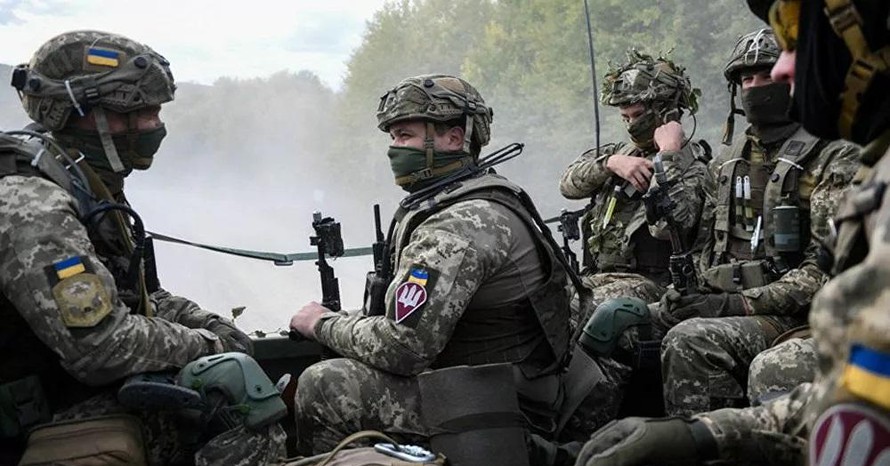On the battlefields of Ukraine, powering on a cell phone could be suicidal, as a rain of fire would follow.
Other electronic equipment such as counter-reflector radars and unmanned aerial vehicle (UAV) control systems, when in operation, pose the risk of resulting in artillery fire or similar missile ambushes. This is the result of electronic warfare, which is likened to an “invisible killer” in Russia’s special military campaign in Russia. Ukraine.
Electronic warfare specializes in targeting the enemy’s communications, positioning and navigation systems, in order to locate, blind, deceive the enemy or assist in launching direct attacks. This type of silent warfare is applied to counter enemy artillery, fighters, cruise missiles, unmanned aerial vehicles (UAVs) as well as to protect forces.
Experts say Russia has a clear advantage over Ukraine in electronic warfare, although this ability is almost not shown in the early stages of the war, when Russian forces close in on the capital Kiev.
However, in the Donbass battlefield, in eastern Ukraine, electronic warfare becomes a much more important factor.
Russia’s Krasukha-4S, Moscow and Murmansk electronic warfare groups participate in a special military operation in Ukraine in a video released on April 15. Video: Russian Defense Forces.
“Russian forces are jamming everything their systems can reach,” said a member of the Aerorozvidka reconnaissance team of the Ukrainian military. “We cannot say they are dominating, but they hinder us a lot.”
A Ukrainian intelligence official described Russia’s electronic warfare as “a rather serious threat” by disrupting reconnaissance efforts and command-and-soldier communications. “Russia jams GPS receivers on UAVs that Ukraine uses to identify and target artillery,” the official said.
Ukraine is said to have achieved some success in countering Russia’s electronic warfare capabilities. They claim to have obtained or destroyed a number of Russian electronic warfare assets, including Krasukha-4 and Borisoglebsk-2 complexes.
Krasukha-4 can jam satellite signals, as well as surveillance radars and guided weapons from a distance of more than 160 km. Borisoglebsk-2, which is considered to be a more advanced weapon, can jam the UAV’s navigation systems and radio signals to detonate guided mines.
Russian forces also targeted Ukrainian electronic warfare units. The Russian Defense Ministry announced on May 26 that the Russian military destroyed a Ukrainian electronic intelligence center in Dniprovske, Mykolaiv province.
Electronic warfare includes three basic elements: reconnaissance, attack and protection. In reconnaissance activities, electronic warfare forces collect intelligence through locating enemy electronic signals.
When attacking, they emit “white noise” to disable or degrade enemy systems, including radio communications, cell phones, air defense radars or artillery radars.
In protection operations, electronic warfare forces can broadcast fake information to deceive the enemy, confuse them and possibly miss the target.
Russia’s Palantin electronic warfare group participates in a special military operation in Ukraine in a video released on June 4. Video: Zvezda.
“Operating on the modern battlefield without data is extremely difficult,” said Colonel Laurie Buckhout, former commander of the US Army’s electronic warfare arm. “Jamming can quickly ‘blind and deaf’ a military aircraft, which is very dangerous, especially when the pilot loses GPS and radar signals while flying at more than 900 km/h.”
Military commanders often rarely mention electronic warfare, especially during combat, for fear of revealing secrets and jeopardizing combat operations. James Stidham, a security expert who once advised the US Department of Homeland Security, commented that electronic warfare is an “extremely tight security” field due to its reliance on many advanced technologies, as well as the benefits to be gained. can be copied and erased very quickly”.
The US military has witnessed the operation of Russian electronic warfare forces in Syria. General Raymond Thomas, former commander of US Special Operations Command, describes the pilots’ communication system America “Frequently crashed in Syria in the most intense electronic warfare environment”, the airborne warning and control system (AWACS) is also “blinded” by advanced Russian complexes.
It is not clear how many weapons and electronic warfare units Russia has deployed in Ukraine. Western experts say that each Russian battalion-level combat group (BTG), consisting of about 1,000 servicemen, is equipped with an electronic warfare unit. The Pentagon says 110 Russian BTGs are fighting in Ukraine.
Experts say that Russia’s special military campaign in Ukraine is becoming a fierce battleground between the electronic warfare forces of both sides, when disabling the UAV becomes the main factor for them to gain advantage. The artillery forces of Russia and Ukraine both rely on reconnaissance drones, which are often considered a decisive factor in battles.
Billionaire Elon Musk has been praised by the Pentagon for a quick software update, helping the Starlink equipment his corporation supplies Ukraine to resist Russian electronic warfare. However, Musk warned Ukrainian soldiers to turn off this device whenever possible, in the face of the threat of “invisible killer” Russia.
“I firmly believe that the Russians are becoming more and more proficient in this area of operation,” said US Air Force lieutenant colonel Tyson Wetzel, a member of the Atlantic Council.
Nguyen Tien (Follow AP)
at Blogtuan.info – Source: vnexpress.net – Read the original article here





